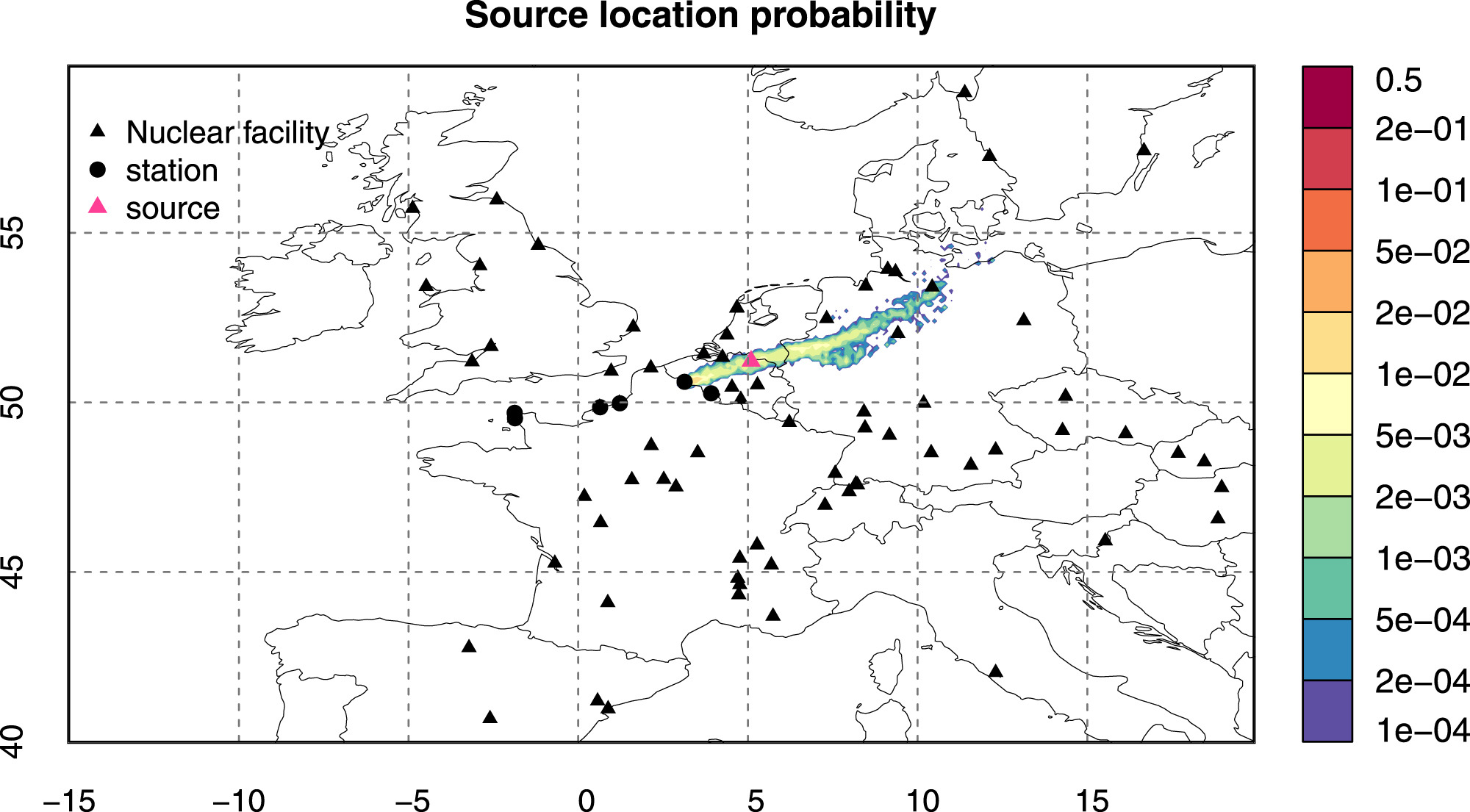FLEXPART for radionuklides
- Bayesian source reconstruction of an anomalous Selenium-75 release at a nuclear research institute
- Ensemble dispersion modeling for the Comprehensive Nuclear Test-Ban Treaty Organization (CTBTO)
- Xenon-133 and caesium-137 releases into the atmosphere from the Fukushima Dai-ichi nuclear power plant
Bayesian source reconstruction of an anomalous Selenium-75 release at a nuclear research institute
Atmospheric transport and dispersion models are important tools in radiation protection as they help to estimate the impact of radionuclides released into the atmosphere. These models can be used in combination with radionuclide observations (airborne concentration measurements, gamma dose rates and deposition observations) to estimate unknown source term parameters, or to improve source term estimates obtained through other methods.
De Meutter et al., 2020 used a Bayesian inference system to determine the source term parameters and their corresponding credible intervals of a real-world anomalous Selenium-75 release at a nuclear facility in Belgium. They proposed a formulation to also take into account true detections, but also true instrumental non-detections, false alarms and real misses.
The Lagrangian particle model Flexpart was used in backward mode to calculate the source–receptor-sensitivities. Airborne 75Se activity concentration observations were used that were measured by the OPERA network, which is part of the French national surveillance program devoted to airborne radionuclides and is operated by IRSN. Weather data obtained from the highest resolution ‘HRES’ configuration of the Integrated Forecast System (IFS) of the European Centre for Medium-Range Weather Forecasts (ECMWF) were used for the atmospheric transport and dispersion simulations.
The posterior for the source longitude and latitude was converted to a source location probability map, shown in the figure below. An important performance confirmation for the Bayesian inference involves comparing the simulated activity concentration as obtained from the inferred source parameters with the actual observations used in the inference.

De Meutter et al., 2020, https://doi.org/10.1016/j.jenvrad.2020.106225
Ensemble dispersion modeling for the Comprehensive Nuclear Test-Ban Treaty Organization (CTBTO)
The Comprehensive Nuclear Test-Ban Treaty Organization (CTBTO) runs to date operationally an atmospheric transport modeling chain in backward mode based on operational deterministic European Centre for Medium-Range Weather Forecasts-Integrated Forecasting System (ECMWF-IFS) and on National Centers for Environmental Prediction-Global Forecast System (NCEP-GFS) input data. Maurer et al., 2021, investigated the potential benefit ensemble dispersion modeling for current and possible future CTBTO applications, by a using data from the ECMWF-Ensemble Prediction System (EPS).
Five different test cases - among which are the ETEX-I experiment and the Fukushima accident - were run in backward or forward mode and - in the light of a future operational application - special emphasis was put on the performance of an arbitrarily selected 10- versus the full 51-member ensemble. They found that for the test cases run in backward mode and based on a puff release it became evident that Possible Source Regions (PSRs) can be reduced in size compared to results based solely on the deterministic run (by applying minimum and probability of exceedance ensemble metrics).

Maurer et al., 2021, https://doi.org/10.1016/j.jenvrad.2021.106649
Xenon-133 and caesium-137 releases into the atmosphere from the Fukushima Dai-ichi nuclear power plant
The Lagrangian particle dispersion model FLEXPARTwas originally developed for calculating the dispersion of radioactive material from nuclear emergencies but has since been used for many other applications as well. For this study, FLEXPART was driven with three-hourly operational meteorological data from two different sources, namely the European Centre for Medium-Range Weather Forecasts (ECMWF) analyses, and the National Centers for Environmental Prediction (NCEP) Global Forecast System (GFS) analyses.
In this study, they estimated the total releases of the radioactive isotopes 133 Xe and 137 Cs as well as their temporal emission patterns from the damaged Fukushima Dai-ichi nuclear power plant (FD-NPP) in March and April 2011. The estimate is based on an inverse modeling method, using the transport model FLEXPART and a large number of available concentration and deposition measurements in Japan, North America, Europe, and a few other locations. Despite the significant uncertainties in simulations as well as measurements, the inversion method was able to produce model results that are largely consistent with the measurement data.

Stohl, et al., 2012, https://doi.org/10.5194/acp-12-2313-2012